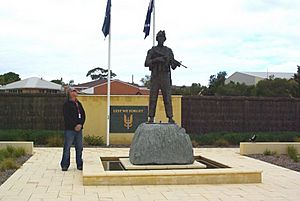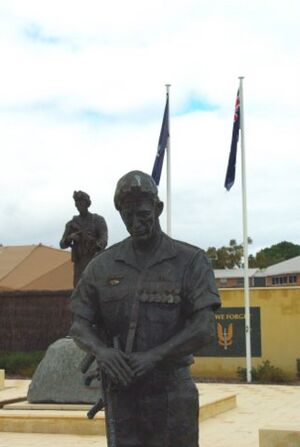Robert Hitchcock facts for kids
Quick facts for kids
Robert Hitchcock
|
|
|---|---|

Hitchcock standing next to one of his (larger than life) figures at the SAS Garden of Reflection, Perth, Western Australia
|
|
| Born |
Robert Charles Hitchcock
18 August 1944 Perth, Western Australia, Australia
|
| Nationality | Australian |
| Education | Perth Tech College |
| Known for | sculpture, drawing |
|
Notable work
|
Figurative work, portrait busts, life-size sculptures, horses, abstract |
| Movement | Bronze sculpture, modernism |
Robert Charles Hitchcock (born 18 August 1944) is a famous Australian sculptor. He started his art career in 1970. Robert Hitchcock creates sculptures using many different subjects and materials. He is known as one of Australia's top sculptors who makes sculptures of people. Many of his large, life-size bronze sculptures can be found in private collections and as public artworks in Australia and other countries.
Contents
Robert Hitchcock's Early Life
Robert Hitchcock was born in Perth, Western Australia. He has both Irish and indigenous Australian family roots. When he was young, he worked as a carpenter. In his early twenties, he began studying art at the Perth Tech College.
He first wanted to study painting. However, an accident as a child affected his eyesight. This made it hard for him to see and mix colors. He soon realized he was much better at creating three-dimensional art, like sculptures.
His first sculptures were experiments. They used many different techniques and styles. He often created realistic figures and animals in motion. Later, he started making more abstract and stylized shapes. After finishing college in 1969, he worked in factories. There, he learned how to work with plaster, fiberglass, and bronze.
Robert Hitchcock's Sculpting Career
Robert Hitchcock received his first art job in 1970. He was asked to sculpt a famous racehorse named Aquanita. This sculpture was a quarter of the horse's actual size. As his fame grew, he received many more jobs from the horse racing world. He sculpted horses for racing, pacing, polo, and quarter horse events. These early works led to even bigger projects later on. He created huge, larger-than-life horse sculptures for public display in places like Norseman, Merredin, and Moora in Western Australia.
Growing Recognition for His Art
In the 1970s, Robert Hitchcock's work became more and more recognized. He created a series of sculptures of the famous Russian ballet dancer Rudolf Nureyev. Throughout his career, he has sculpted many well-known and "interesting people." These include singer Leonard Cohen, writer Rod McKuen, Professor Ian Constable, composer Beethoven, and poet Robbie Burns. He also sculpted many important Australian public figures and sports stars.
Towards the end of the 1970s, Hitchcock's bronze sculptures became much larger. This made them perfect for public art projects. One of his most important works is his sculpture of Yagan.
The Yagan Statue Project
From the mid-1970s, members of the Noongar community wanted a statue of Yagan. Yagan was an important Aboriginal warrior. They wanted the statue for the 1979 celebrations of Western Australia's 150th anniversary. However, their requests were turned down. The Premier of Western Australia at the time, Charles Court, was told by a historian that Yagan was not important enough for a statue.
The Noongar community then formed a "Yagan Committee." They worked hard and raised enough money to ask Robert Hitchcock to create the statue. He created a life-size bronze statue of Yagan. It shows Yagan standing without clothes, holding a spear across his shoulders. The Yagan statue was officially opened on September 11, 1984. It stands on Heirisson Island in the Swan River near Perth.
Recent Works and Achievements
In the year 2000, Robert Hitchcock moved into his current, larger studio. He continues to be a very popular and sought-after artist. One of his recent important projects was for the SAS Garden of Reflection in Perth.
This project includes three sculptures of SAS soldiers. They are larger than life-size. One figure wears a uniform from 1957, when the SAS started in Australia. The other two wear modern combat uniforms and carry weapons. These sculptures are incredibly detailed. They show a very true picture of an Australian SAS soldier.


